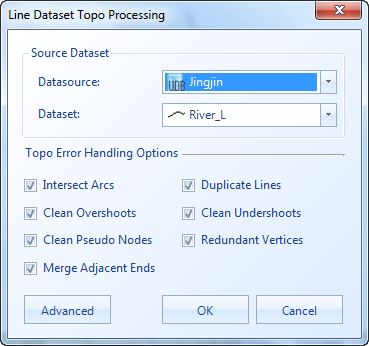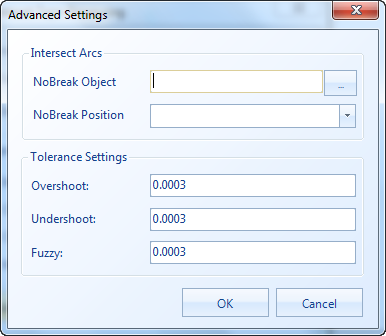line topology processing
Instructions for use
Perform validate topology and repair on line datasets or network datasets.
Function Entrance
- Data Tab->Topology Group->Line Topology Processing.
Operation Steps
- Click the Line Topology Processing button to display the dialog box as shown below:

Figure: "Line Dataset Topology Processing" Dialog Box - Select the source dataset that requires topology processing. You can choose a line dataset or a network dataset.
- Select topology error handling options. Topology error handling options include seven rules: remove pseudo nodes, redundant vertices, remove duplicate lines, remove overshoots, remove long dangles, merge adjacent ends, and intersect arcs. Users can select appropriate rules as needed to perform topology processing on the selected dataset. For detailed descriptions of topology processing rules, refer to Topology Processing Rules. When performing topology processing, the system validates topology on the line dataset according to the selected topology rules and corrects detected topology errors.
- Click the Advanced button to display the advanced settings dialog box as shown below. In this dialog box, you can set non-breaking lines and tolerances for related topology processing rules.

- Intersect Arcs: Set non-breaking line parameters; lines meeting these parameters will not be broken.
- Non-breaking objects: After setting a filter expression, the system will not break line objects that satisfy the expression. Click the “...” button on the right to open the SQL Expression dialog box, where users can enter the expression. For details, refer to SQL Expression.
- Non-breaking locations: Determine non-breaking locations by selecting a point dataset from the drop-down list on the right. Whether a line object is broken depends on whether the distance between point objects in the selected point dataset and adjacent line objects is within the tolerance.
If non-breaking objects are not set, all line objects undergo intersect arcs operation by default. If non-breaking locations are not set, all line objects undergo intersect arcs operation by default. If both are set, the system handles the union of both objects.
- Tolerance Settings: Tolerance settings include three parts: short dangle, long dangle, and fuzzy, targeting remove overshoots, extend undershoots, and other topology processing rules requiring node distance checks. The default value of fuzzy depends on the dataset's coordinate system; for details, refer to Tolerance Description. Short dangle and long dangle defaults use the tolerance set in dataset properties; if unset, they default to 100 times the fuzzy tolerance.
- Intersect Arcs: Set non-breaking line parameters; lines meeting these parameters will not be broken.
- Click the OK button to perform topology processing on the selected line dataset.
 Note:
Note:- To perform "remove overshoots" on line data, you must also check the "intersect arcs" option to ensure correct line topology processing results.
- Topology processing is performed directly on the selected line dataset and does not generate a new result dataset. Therefore, a prompt interface appears before execution: "This operation will modify the source data. Continue?" to confirm direct operation on the source data. If you do not want to modify the source data, back up the data before validating topology.
- To perform "remove overshoots" on line data, you must also check the "intersect arcs" option to ensure correct line topology processing results.
Related Topics



